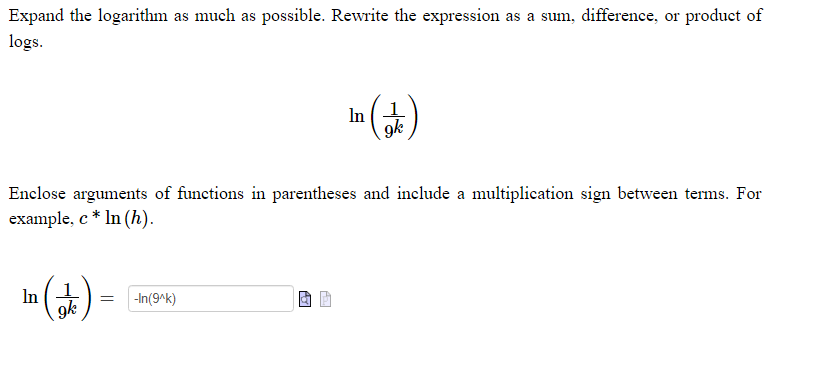Expand the logarithm as much as possible

The Correct Answer and Explanation is:
The correct expanded form of the expression
ln(19k)\ln\left(\frac{1}{9k}\right)
is
−ln(9)−ln(k)-\ln(9) – \ln(k)
Explanation
To expand the logarithmic expression ln(19k)\ln\left(\frac{1}{9k}\right), we apply the fundamental properties of logarithms. These properties allow us to rewrite complex logarithmic expressions as simpler components involving sums, differences, or constants multiplied by logs.
We begin with the quotient rule for logarithms, which states:
ln(ab)=ln(a)−ln(b)\ln\left(\frac{a}{b}\right) = \ln(a) – \ln(b)
In our case, a=1a = 1 and b=9kb = 9k, so:
ln(19k)=ln(1)−ln(9k)\ln\left(\frac{1}{9k}\right) = \ln(1) – \ln(9k)
Next, we use the fact that the natural logarithm of 1 is zero:
ln(1)=0\ln(1) = 0
This simplifies the expression to:
0−ln(9k)=−ln(9k)0 – \ln(9k) = -\ln(9k)
Now we apply the product rule for logarithms, which states:
ln(ab)=ln(a)+ln(b)\ln(ab) = \ln(a) + \ln(b)
Here, a=9a = 9 and b=kb = k, so:
ln(9k)=ln(9)+ln(k)\ln(9k) = \ln(9) + \ln(k)
Substituting this into our previous result:
−ln(9k)=−(ln(9)+ln(k))=−ln(9)−ln(k)-\ln(9k) = -(\ln(9) + \ln(k)) = -\ln(9) – \ln(k)
Thus, the fully expanded form is:
−ln(9)−ln(k)-\ln(9) – \ln(k)
This expansion is important because it demonstrates how logarithmic expressions can be broken down into simpler parts. This is especially useful in calculus, algebra, and scientific applications where simplifying expressions helps in solving equations or analyzing functions. Mastery of these properties also aids in understanding the inverse relationship between logarithmic and exponential functions.
